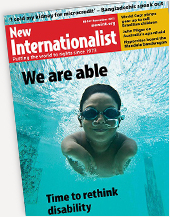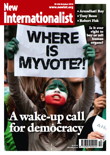Within a year of being crowned king in 1932, Abdul Aziz ibn Saud, founder of modern Saudi Arabia, had signed an exclusive concession with Standard Oil, run by the US oil giant Chevron.
In return, the US would enter a formal military alliance with the kingdom, to protect it from rivals. Thus was established a pattern of relationships that continues today: the West props up Saudi repression to maintain ‘stability’ – meaning access to regional oil and gas – while the Saudis use their oil wealth to buy protection wherever needed.
By 1944, Chevron brought in fellow oil majors Exxon, Mobil and Texaco to consolidate Standard into the Arabian American Oil Company, ARAMCO, which effectively functioned as a proxy for the US government in Saudi Arabia.1
Support independent journalism.
Help us meet our fundraising goal of £30,000 ($42,000):

Please click to donate.
‘The best regime’
By 1971, British ambassador to Saudi Arabia William Morris described Saudi Arabia’s specific role as guarantor of regional ‘stability’ with candour: ‘Our narrow commercial interests are of lesser importance than the politico-strategic-economic interest to us of Saudi Arabia as a major supplier of oil to the West… however unsatisfactory, this is the best regime in Saudi Arabia we have, or can count on getting. There is little or nothing we can do to improve it, so we must make the best of what it is.’
The decision to accept Saudi Arabia as ‘the best regime’ to guarantee Western fossil-fuel interests in the Gulf lives on today. Its ISIS-like ideology and financing of terrorism continues to be largely ignored by Western governments.
According to a 2009 secret cable from then US Secretary of State Hillary Clinton, ‘donors in Saudi Arabia constitute the most significant source of funding to Sunni terrorist groups worldwide’. The cable described Saudi Arabia as ‘a critical financial support base for al-Qaeda, the Taliban, LeT [Laskhar-e-Toiba], and other terrorist groups’ and said that Riyadh had only taken limited action to disrupt terror financing.2
This is nothing new. After 9/11, a joint Congressional inquiry into the attacks discovered a CIA memo confirming ‘incontrovertible evidence that there is support for these terrorists [9/11 hijackers Khalid Almidhar and Nawaf Alhamzi] within the Saudi government’. The memo was published as part of a report that had been unilaterally classified by the White House. The Obama administration has continued to rebuff repeated demands from the 9/11 families to declassify those pages.3
When British historian Mark Curtis, author of Secret Affairs: Britain’s Collusion with Radical Islam, submitted a Freedom of Information Act request to the UK Foreign Office for its assessment of terrorist funding from Saudi Arabia, he was told: ‘Disclosure of information is likely to prejudice relations between the UK and Saudi Arabia.’
Funding Islamist militancy is only one part of this equation. The other involves mobilizing oil wealth to buy silence, support and influence. In the US, much Saudi investment goes towards energy research to prolong the kingdom’s declining fossil-fuel resources. Tens of billions of dollars have gone to Stanford, Cornell, Texas A&M, UC Berkeley, CalTech, among others to develop technologies that can extract more oil per well, discover new reserves, and advance carbon capture methods that might permit continued fossil-fuel exploitation.4
But none of this has prevented Saudi Arabia’s oil empire from crumbling.
Oil collapse
The plummeting price of oil, down from $115 in 2014 to under $30 earlier this year, has hit oil-producing nations hard. Saudi Arabia could have chosen to reduce supply in a bid to push up the price, but instead kept the taps open to try to increase its global market share.
The world – and in particular the US – has been shifting away from Middle Eastern oil to sources from the Americas, including shale and tar sands. A spate of recent studies and forecasts shows that by mid-century, Saudi Arabia is destined to lose its dominance over global oil markets to other producers such as Canada and Venezuela. The prospect of parts of ARAMCO, Saudi’s highly secretive national oil company, being sold off to the private sector, was raised earlier this year by Deputy Crown Prince Mohammed bin Salman.
The kingdom is cagey about disclosing the scale of its reserves, but there are reports that it is running out of cheap oil. A study in the Journal of Petroleum Science and Engineering predicts that Saudi Arabia’s oil production will peak then inexorably decline in 2028.5 And according to the Export Land Model created by Texas petroleum geologists, Saudi net oil exports have been in decline over the last decade.6 The geologists show that a major factor is rising domestic consumption.7
In 2012, Citigroup observed that Saudi electricity production is growing at about eight per cent a year.8 A quarter of the country’s total fuel production is used domestically. At this rate Saudi Arabia’s net oil exports could decline to zero by 2030.
At this rate Saudi Arabia’s net oil exports could decline to zero by 2030
During Paris COP21, Nour O Shihabuddin of ARAMCO confirmed that investing in renewables for domestic energy consumption would free up more oil for export.9
Meanwhile, the money too is dwindling. In September last year, I reported that if Saudi Arabia’s considerable cash reserves continued to deplete at the rate of about $12 billion a month, by late 2018 the kingdom’s reserves could hit just $200 billion (compared with $650 billion at the end of 2015). This would trigger capital flight, and could lead to bankruptcy.10
A month later, the IMF provided a more radical forecast, saying that on its current course, Saudi Arabia would deplete its cash reserves and go bankrupt in just five years. Adjustment plans ‘are currently insufficient to address the large fiscal challenge,’ warned the agency.11
Imperial overstretch
As Saudi Arabia’s economic and energy security has declined, its resort to military expansionism has intensified, resulting in hundreds of millions of dollars of support to extremist rebels in Syria, a prolonged war in Yemen, support for Bahrain’s ongoing sectarian crackdown on Shi’a democracy activists, and the formation of a regional ‘anti-terror’ coalition of Muslim states ready to commit military forces.
All this is consistent with Saudi Arabia’s traditional role, codified under the Nixon Doctrine derogating the regime as a regional policeman. As a ‘pillar’ of the Gulf, Saudi Arabia’s role, among other regional US client-regimes, was to oversee regional security with extensive Western military support.
Billions of dollars of US and British arms sales to the Saudi kingdom have directly supported these adventures. The militarization of Saudi policy is, in other words, a direct function of its relationship with the West. To sustain ‘stability’ the kingdom’s US and British backers are resorting to what they know best: empowering Saudi Arabia’s domestic police-state and expanding its regional influence.
Last November the regime proposed measures for economic reform, including pervasive privatization of state enterprises and deep budget cuts, especially in relation to energy subsidies.
Saudi planners appear to have forgotten that subsidy reductions on essential food and fuel items played a major role in triggering the Arab Spring in countries like Egypt and Syria. Neoliberal reforms in those countries did little but widen inequalities and entrench corruption, as political repression to stave off crisis increased, often with Western complicity.
Judging by this recent history, the kingdom’s days are numbered. The West’s key pillar of regional ‘stability’ is beginning to crumble.
- FPRI nin.tl/US-Saudi-history ↩
- Mark Curtis nin.tl/Saudi-Bahrain ↩
- Middle East Eye nin.tl/Nafeez-Ahmed ↩
- The National Interest nin.tl/saudi-shapes-us-research ↩
- Science Direct nin.tl/crude-oil-forecast ↩
- Resilience nin.tl/future-net-oil-exports ↩
- BMO Research nin.tl/domestic-oil-demand ↩
- Bloomberg nin.tl/saudi-import-oil-2030 ↩
- Newsweek nin.tl/saudi-kill-cop21 ↩
- Middle East Eye nin.tl/KSA-collapse-inevitable ↩
- The Independent nin.tl/KSA-bankrupt-5yrs ↩
 This feature was published in the March 2016 issue of New Internationalist. To read more,
buy this issue
or subscribe.
This feature was published in the March 2016 issue of New Internationalist. To read more,
buy this issue
or subscribe.
![01.03.16-oil-on-skids-590.jpg [Related Image]](/web/20160313225015im_/http://newint.org/features/2016/03/10/01.03.16-oil-on-skids-590.jpg)




Comments on Oil on the skids
Leave your comment
Registration is quick and easy. Plus you won’t have to re-type the blurry words to comment!
Register | Login
...And all is quiet.
Subscribe to Comments for this article
Guidelines: Please be respectful of others when posting your reply.